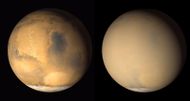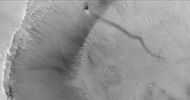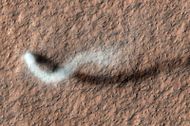Difference between revisions of "Dust devils"
m (→Images) |
m |
||
| Line 10: | Line 10: | ||
One team of researchers found that on any given day on average about one dust devil pops up for every per square kilometre of surface. With a 145 million square kilometer surface area that means that – there are millions of dust devils every day on Mars. One would be able to see dozens of them at any one time.<ref> https://www.newscientist.com/article/2143217-marss-surface-hosts-millions-of-towering-dust-devils-every-day/</ref> <ref> https://arxiv.org/abs/1708.00484</ref> <ref>Jackson, B., et al. 2018. Framework for Relating the Structures and Recovery Statistics in Pressure Time-Series Surveys for Dust Devils. Icarus. 299: 166-174.</ref> | One team of researchers found that on any given day on average about one dust devil pops up for every per square kilometre of surface. With a 145 million square kilometer surface area that means that – there are millions of dust devils every day on Mars. One would be able to see dozens of them at any one time.<ref> https://www.newscientist.com/article/2143217-marss-surface-hosts-millions-of-towering-dust-devils-every-day/</ref> <ref> https://arxiv.org/abs/1708.00484</ref> <ref>Jackson, B., et al. 2018. Framework for Relating the Structures and Recovery Statistics in Pressure Time-Series Surveys for Dust Devils. Icarus. 299: 166-174.</ref> | ||
| − | A picture of a dust devil that was previously imaged in 2009, showed the tracks visible from two years before were completely different from the old ones meaning there had been a dust storm erased the old tracks.<ref>http://www.uahirise.org/ESP_031199_2070|title=Dust Devil Tracks|last=|first=|date=15 May 2013|website=HiRISE.com|publisher=|access-date=30 November 2016</ref> | + | A picture of a dust devil that was previously imaged in 2009, showed the tracks visible from two years before were completely different from the old ones meaning there had been a dust storm erased the old tracks.<ref>http://www.uahirise.org/ESP_031199_2070|title=Dust Devil Tracks|last=|first=|date=15 May 2013|website=HiRISE.com|publisher=|access-date=30 November 2016</ref> The picture below shows how a dust storm can quickly cover the entire planet. |
<gallery class="center" widths="190px" heights="180px"> | <gallery class="center" widths="190px" heights="180px"> | ||
Revision as of 10:42, 29 May 2018
Dust devils are a common appearance on the Martian surface. They show local atmospheric turbulences.
Dust devils leave dark marks on the surface of Mars because they disturb a thin coating of fine bright dust that covers most of the Martian surface. If a dust devil goes by the coating of dust is removed, consequently exposing an underlying dark surface. Within a few weeks, the dark track assumes its former pale color, either by being re-covered through wind action or due to surface oxidation through exposure to sunlight and the Martian atmosphere.
Contents
Formation and dynamics
Dust devils occur when the sun warms up the air near a flat, dry surface. The warm air then rises quickly through the cooler air and begins spinning while moving ahead. This spinning, moving cell may pick up dust and sand and leave behind a clean surface.[1]
Observations
Dust devils on Mars have been photographed both from the ground and high overhead from orbit. They did scientists a big favor by blowing dust off the solar panels of two Rovers on Mars, thereby greatly extending their useful lifetime.[2] The pattern of the tracks has been shown to change every few months.[3] A study that combined data from the High Resolution Stereo Camera (HRSC) and the Mars Orbiter Camera (MOC) found that some large dust devils on Mars have a diameter of 700 meters and last at least 26 minutes.[4] One dust devil was measured at having a 12 mile height. [5] One team of researchers found that on any given day on average about one dust devil pops up for every per square kilometre of surface. With a 145 million square kilometer surface area that means that – there are millions of dust devils every day on Mars. One would be able to see dozens of them at any one time.[6] [7] [8]
A picture of a dust devil that was previously imaged in 2009, showed the tracks visible from two years before were completely different from the old ones meaning there had been a dust storm erased the old tracks.[9] The picture below shows how a dust storm can quickly cover the entire planet.
Images of dust devils and dust devil tracks
References
- ↑ HiRISE | (PSP_00481_2410). Hirise.lpl.arizona.edu. Retrieved on 7 August 2011.
- ↑ http://marsrovers.jpl.nasa.gov/gallery/press/spirit/20070412a.html Mars Exploration Rover Mission: Press Release Images: Spirit]. Marsrovers.jpl.nasa.gov. Retrieved on 7 August 2011.
- ↑ http://hirise.lpl.arizona.edu/PSP_005383_1255
- ↑ Reiss, D. et al. 2011. Multitemporal observations of identical active dust devils on Mars with High Resolution Stereo Camera (HRSC) and Mars Orbiter Camera (MOC). Icarus. 215:358-369.
- ↑ https://www.nasa.gov/mission_pages/MRO/news/mro20120404.html
- ↑ https://www.newscientist.com/article/2143217-marss-surface-hosts-millions-of-towering-dust-devils-every-day/
- ↑ https://arxiv.org/abs/1708.00484
- ↑ Jackson, B., et al. 2018. Framework for Relating the Structures and Recovery Statistics in Pressure Time-Series Surveys for Dust Devils. Icarus. 299: 166-174.
- ↑ http://www.uahirise.org/ESP_031199_2070%7Ctitle=Dust Devil Tracks|last=|first=|date=15 May 2013|website=HiRISE.com|publisher=|access-date=30 November 2016
See also
| This article is a stub. You can help Marspedia by expanding it. |















